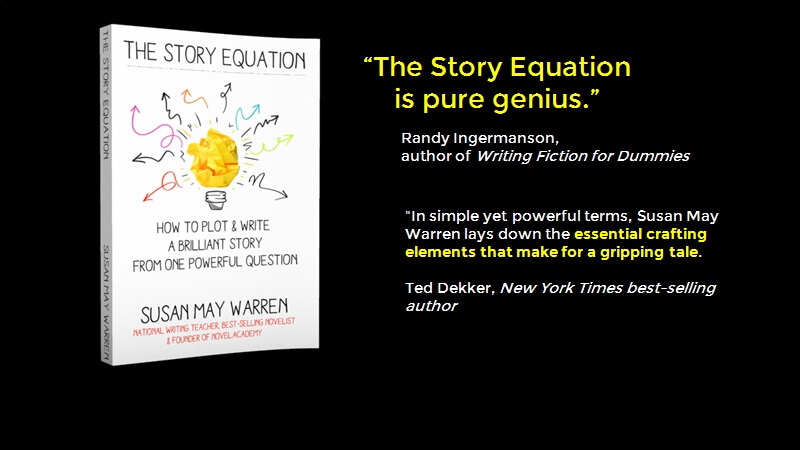by Susan May Warren
Writing Description...
Is it telling? Showing? Actually both—you must tell us what the character is seeing. BUT, you also need to do it in a way that helps us FEEL the character’s emotions, and that means SHOWING.
In other words, because we’re always trying to SHOW the character’s emotions, the way they feel about being in a place, or seeing someone is portrayed through their perspective as they describe what they see.
Often, I see clients step out of the POV as they describe something, (as if it were an objective description) and then hop back in to continue the story. But every POV brings their perspective into description—and layered into the story, will reveal character and emotion.
In other words, because we’re always trying to SHOW the character’s emotions, the way they feel about being in a place, or seeing someone is portrayed through their perspective as they describe what they see.
Often, I see clients step out of the POV as they describe something, (as if it were an objective description) and then hop back in to continue the story. But every POV brings their perspective into description—and layered into the story, will reveal character and emotion.
Let’s take a look:
First, there are two kinds of description: Static, and Active. For my next few posts, we’ll dive into Static Description, take it apart and look at how to add an emotional element to it, so it gives your story power.
Static description is used when we want to make a point, focus in on something…like when we see someone for the first time, or walk into a room, or are given or shown something of importance.
When I’m writing Static Description, I like to use the acronym: FOCUS because it helps me think about the different components of static description.
I like to use the word FOCUS because it reminds me to look the eyes of the character, like I would a camera. In essence, I’m taking a “snapshot” for the reader.
This is from Lily’s POV:
First, there are two kinds of description: Static, and Active. For my next few posts, we’ll dive into Static Description, take it apart and look at how to add an emotional element to it, so it gives your story power.
Static description is used when we want to make a point, focus in on something…like when we see someone for the first time, or walk into a room, or are given or shown something of importance.
When I’m writing Static Description, I like to use the acronym: FOCUS because it helps me think about the different components of static description.
I like to use the word FOCUS because it reminds me to look the eyes of the character, like I would a camera. In essence, I’m taking a “snapshot” for the reader.
This is from Lily’s POV:
The chiffon curtains blew in the traffic clatter and the dusty, smoky redolence of the busy Champs-Élysées, tempered only by the faintest hint of the new horse chestnut blossoms along the boulevard. The luster of la Belle Époque de Paris vanished the moment Lilly stepped out onto the balcony of the Worth family’s Paris estate shortly after her arrival and discovered an encampment of hungry-eyed war orphans leering at her, yearning for breadcrumbs.
The gendarmes chased them away and Lilly had the sense of prairie dogs scattering at the sound of a .22. She could have sent down her tray of café au lait and brioche. She longed for American faire anyway – perhaps a boiled egg, or even a piece of bacon.
The congestion of traffic outside her window – horses pulling carriages, buses belching out black exhaust, trolley cars and Citroens weaving in and out of foot traffic – reminded her too well of their view in New York City. It made her want to close her window, hide inside the safely of the brocade-papered walls, the crackle of the fire in the hearth.Can you sense that she doesn’t like Paris?
Now, let’s take a look at the SAME place in Rosie’s POV:
Rosie longed for the energy, the joie de vivre of Paris to sweep her up, carrying her down the Champs-Élysées, and into a different life. She may be attending a funeral, the mood more somber as she entered the surge of the crowd, but Paris never did anything without flourish. A band played as the spectacle of Sarah’s Berhardt’s grand final procession urged onto the street all manner of observer. Sailors, dressed for leave, and displaced soldiers still lingering after the war, as if searching for something they’d lost. Frenchmen in bow ties and straw hats, matrons in pearls and furs, despite the spring air, and everywhere Rosie looked, young women in low-waisted dresses, felt cloque hats and men in baggy suits all hustled behind the carriage.Can you see the difference? It’s all about how they feel about being there. We layer in their attitude while they describe the scene.
It’s all about asking your character: How do you feel about being here? And then layering in this attitude via the way they describe it.
In three weeks, (March 30th) we’ll dive into the Acronym and I’ll show you how to add in emotion and create a powerful word-picture with your description.
Until then...
Go! Write something Brilliant!
TWEETABLES
Susan May Warren is owner of Novel Rocket and the founder of Novel.Academy. A Christy and RITA award-winning author of over fifty novels with Tyndale, Barbour, Steeple Hill, Summerside Press and Revell publishers, she's an eight-time Christy award finalist, a three-time RITA Finalist, and a multi-winner of the Inspirational Readers Choice award and the ACFW Carol. A popular writing teacher at conferences around the nation, she's also the author of the popular writing method, The Story Equation. A full listing of her titles, reviews and awards can be found at: www.susanmaywarren.com. Contact her at: susan@mybooktherapy.com.

























Asking a character "how do you feel" clarifies so much. Thank you for sharing.
ReplyDelete